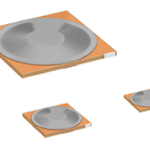An ultra-compact high accuracy seismic detection sensor module, the BP3901, targets applications requiring reliable earthquake detection, such as automatic doors, unmanned transport vehicles, and smart meters.
The ultra-compact (11.8×8.6×2.5-mm) BP3901 integrates an original earthquake detection algorithm  and offers high accuracy. In addition, a false detection prevention function is built in and it is capable of accurately distinguishing between vibration due to earthquakes or other external factors. It also has an angle correction function (±15° allowable mounting angle) that can correct for unintentional tilt of the module, further improving detection accuracy.
and offers high accuracy. In addition, a false detection prevention function is built in and it is capable of accurately distinguishing between vibration due to earthquakes or other external factors. It also has an angle correction function (±15° allowable mounting angle) that can correct for unintentional tilt of the module, further improving detection accuracy.
The BP3901 incorporates a 3-axis accelerometer (from ROHM Group company Kionix). ROHM developed a unique algorithm focused on determining SI (Spectrum Intensity) values. This algorithm features a high correlation with measured seismic intensity data used for earthquake damage assessment while it also optimizes the digital signal processing of acceleration data and calculation parameters/sequence through analysis of measured excitation data. This makes it possible to accurately measure the seismic level, enabling more precise earthquake detection compared with conventional mechanical sensors.
A false detection prevention function distinguishes between seismic and external factors’ vibrations. In applications requiring earthquake detection, false detection can occur due to various vibrations caused by collisions with external objects. However, by conducting detailed analysis of vibration waveforms and integrating a false detection prevention function, ROHM was able to distinguish between waveforms due to external factors’ vibrations and actual seismic events.
Conventional earthquake detectors can encounter problems in detecting earthquakes due to deviations in the internal seismic detection function and inclination that occurs over time. In contrast, the BP3901 achieves angle correction by combining the characteristics of the built-in accelerometer with new angle compensation operation. This allows it to correct for inclination within the vertical planes by up to ±15° (3x that of conventional products) in response to the gravitational acceleration of the Earth.
The module is designed to stay in standby mode until a seismic event is detected. The BP3901 achieves low standby current consumption (3.5 μA) by optimizing arithmetic processing. For example, installing this module in a fan heater exposed to an average of 10 seismic events a month (duration: 180 sec/time) enables operation for up to 5 years or more on just 2 alkaline AA batteries (in series).
The BP3901 saves calculated seismic data in non-volatile memory when the vibration exceeds a certain level. The last 16 seismic events can be stored in order of earthquake magnitude. Analyzing earthquake data collected at various locations will make it possible to predict future earthquakes. In addition, by enabling comparison of past earthquake data with damage conditions and equipment deterioration it is also expected to see use in earthquake recovery work and maintenance prioritization.
ROHM Semiconductor, 2323 Owen Street, Santa Clara, CA 95054, www.rohm.com





Leave a Reply